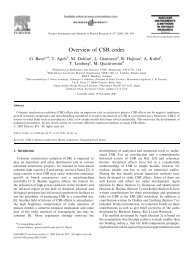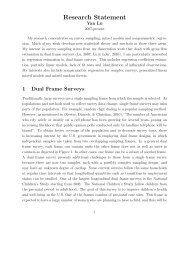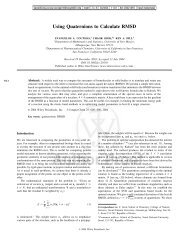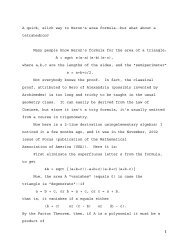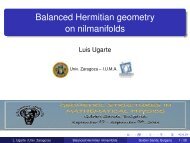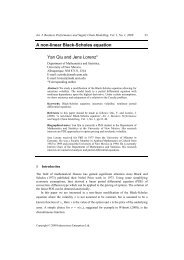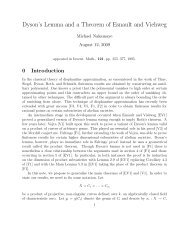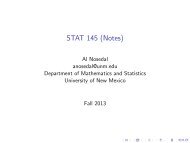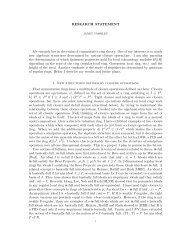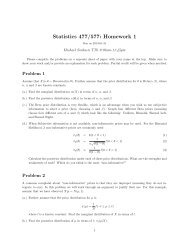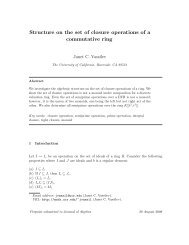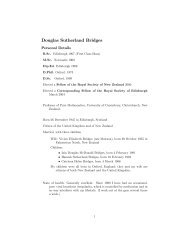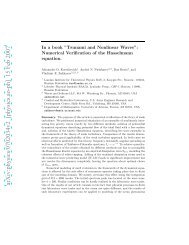OEO Office of Equal Opportunity - Department of Mathematics and ...
OEO Office of Equal Opportunity - Department of Mathematics and ...
OEO Office of Equal Opportunity - Department of Mathematics and ...
You also want an ePaper? Increase the reach of your titles
YUMPU automatically turns print PDFs into web optimized ePapers that Google loves.
294 ARTS AND SCIENCES<br />
Ph.D. in Spanish <strong>and</strong> Portuguese<br />
The <strong>Department</strong> <strong>of</strong>fers a Ph.D. in Spanish <strong>and</strong> Portuguese,<br />
with a concentration in one <strong>of</strong> the following fields: Literature<br />
or Linguistics.<br />
Degree Description<br />
The Ph.D. in Spanish <strong>and</strong> Portuguese at the University <strong>of</strong><br />
New Mexico requires a minimum <strong>of</strong> 63 hours <strong>of</strong> graduate<br />
courses (not including dissertation hours), which may include<br />
up to 30 hours <strong>of</strong> M.A. course work. The degree consists <strong>of</strong> a<br />
major concentration <strong>and</strong> one or more minor concentrations; a<br />
double major may be taken in lieu <strong>of</strong> minors, with 48 hours <strong>of</strong><br />
post-M.A. course work required (total hours required, including<br />
M.A.=78). All course work in Spanish must be at the 500-<br />
or 600- level, with the exception <strong>of</strong> Mexican Literature (SPAN<br />
438), <strong>and</strong> Cervantes’ Quijote (SPAN 423).<br />
1. MAJOR CONCENTRATION: The two major areas<br />
in Spanish are Hispanic Literature <strong>and</strong> Hispanic<br />
Linguistics. The major requires a minimum <strong>of</strong> 24 hours.<br />
The major in Hispanic Literature will consist <strong>of</strong> a concentration<br />
in a genre (narrative, poetry, theater) <strong>and</strong> a<br />
period (Medieval, Renaissance/Golden Age/Colonial,<br />
18th <strong>and</strong> 19th Centuries, 20th Century). The major<br />
in Hispanic Linguistics will include a concentration in<br />
Descriptive, Historical, or Applied Hispanic Linguistics.<br />
2. NON-TRANSCRIPTED Ph.D. MINOR<br />
CONCENTRATION: All c<strong>and</strong>idates, except those pursuing<br />
double majors, must complete a minor area<br />
consisting <strong>of</strong> a minimum <strong>of</strong> 12 hours. The minor may<br />
be taken in the <strong>Department</strong> or outside, in consultation<br />
with the Committee on Studies. Suggested minor<br />
areas are Portuguese, Hispanic Southwest Studies,<br />
Literary Theory, History, Hispanic Women Studies, Latin<br />
American Studies, or a subfield in the major areas.<br />
3. REQUIRED COURSES: Either SPAN 542 (History <strong>of</strong><br />
the Spanish Language) or PORT 561 (History <strong>of</strong> the<br />
Portuguese Language) <strong>and</strong> PORT 461 (Portuguese<br />
Graduate Studies) are required <strong>of</strong> all students with a<br />
concentration inlinguistics; SPAN 601 (Literary Theory)<br />
<strong>and</strong> 6 hours <strong>of</strong> Portuguese 400 level or above are<br />
required <strong>of</strong> all students with a concentration in literature.<br />
Spanish or Portuguese Ph.D. Language<br />
Requirement<br />
Research at the graduate <strong>and</strong> pr<strong>of</strong>essional levels is enhanced<br />
by the mastery <strong>of</strong> several languages. Students are advised to<br />
consider their pr<strong>of</strong>essional research goals in selecting a language<br />
to fulfill the department’s requirement.<br />
All Ph.D. c<strong>and</strong>idates must demonstrate pr<strong>of</strong>iciency equivalent<br />
to two years <strong>of</strong> university-level study in a language apart<br />
from English <strong>and</strong> the student’s language <strong>of</strong> major study.<br />
This pr<strong>of</strong>iciency is normally demonstrated by completing in<br />
consultation with the department graduate advisor a fourthsemester<br />
or above numbered language course with a grade<br />
<strong>of</strong> B or better. Alternately, the student may complete the<br />
requirement by demonstrating pr<strong>of</strong>iciency equivalent to one<br />
year <strong>of</strong> university-level study in two foreign languages, by<br />
completing second semester or above numbered language<br />
courses in both languages with a grade <strong>of</strong> B or better. This<br />
requirement can be met through course work done as part <strong>of</strong><br />
the B.A. <strong>and</strong>/or M.A.<br />
Detailed information for all these graduate degrees may be<br />
obtained from the <strong>Department</strong> Web pages at http://www.<br />
unm.edu/~spanish/.<br />
Portuguese (PORT)<br />
200. Introduction to Brazilian Culture. (3)<br />
An interdisciplinary introduction to the humanities in Brazil.<br />
Focuses on aspects <strong>of</strong> history, literature, music, thought, art,<br />
architecture <strong>and</strong> popular culture that make Brazil unique in<br />
the western hemisphere. (Taught in English.)<br />
201–202. Intermediate Portuguese I–Intermediate<br />
Portuguese II. [Intermediate Portuguese.] (3)<br />
Intermediate Portuguese for students who have completed<br />
one year <strong>of</strong> beginning language study or its equivalent.<br />
Review <strong>of</strong> grammar <strong>and</strong> expansion <strong>of</strong> conversational <strong>and</strong><br />
composition skills.<br />
275. Intensive Beginning Portuguese. (6)<br />
An intensive one-semester multimedia course using authentic<br />
Brazilian models <strong>of</strong> speech <strong>and</strong> behavior that provide students<br />
with the opportunity to develop communicative skills<br />
in Portuguese.<br />
276. Intensive Intermediate Portuguese. (6)<br />
An intensive one-semester multimedia course that takes<br />
students on a journey through Brazil using realistic language<br />
situations to teach students cultural information <strong>and</strong><br />
provide challenging opportunities to develop a full range <strong>of</strong><br />
Portuguese language skills.<br />
311./511. Culture <strong>and</strong> Composition. (3)<br />
Students develop their vocabulary <strong>and</strong> improve their writing<br />
skills through the study <strong>of</strong> readings, films <strong>and</strong> music from<br />
the Portuguese-speaking world <strong>and</strong> through practice writing<br />
compositions.<br />
Prerequisite: 276.<br />
312./512. Culture <strong>and</strong> Conversation. (3)<br />
Students improve skills in oral communication, including pronunciation<br />
<strong>and</strong> intonation, through the study <strong>and</strong> performance<br />
<strong>of</strong> dramatic scenes, <strong>and</strong> the filming <strong>and</strong> editing <strong>of</strong> those<br />
scenes.<br />
Prerequisite: 276<br />
335. Brazilian Popular Culture. (3)<br />
Through the lens <strong>of</strong> Brazilian daily activities <strong>and</strong> ritual expressions,<br />
this course provides the student with an introduction to<br />
Brazilian history, culture <strong>and</strong> society.<br />
414./514. Topics in Luso-Brazilian Literature <strong>and</strong><br />
Culture. (3, no limit) ∆<br />
An advanced language course emphasizing interdisciplinary<br />
themes in Luso-Brazilian literature <strong>and</strong> culture.<br />
Prerequisite: 311 or equivalent experience.<br />
415./515. Popular Brazilian Music I. (3)<br />
Survey <strong>of</strong> Brazilian popular music from its origins at the end <strong>of</strong><br />
the 19th century to 1950 concentrating on forms from the cultural<br />
centers in the south <strong>of</strong> Brazil as well as regional music.<br />
416./516. Brazilian Cinema. (3)<br />
Survey <strong>of</strong> Brazilian cinema concentrating on the Cinema Novo<br />
movements <strong>of</strong> the 1950s <strong>and</strong> 1960s. Cinema is presented as<br />
an expression <strong>of</strong> national identity <strong>and</strong> is understood in relationship<br />
to literature <strong>and</strong> other cultural expressions.<br />
417./517. Popular Brazilian Music II. (3)<br />
Survey <strong>of</strong> Brazilian popular music from 1950 to 2000 concentrating<br />
on contemporary sounds from the cities <strong>of</strong> Rio de<br />
Janeiro <strong>and</strong> Sao Paulo as well as new music from Brazil’s<br />
other regions.<br />
421./521. Brazilian Theater. (3)<br />
A survey <strong>of</strong> 19th- <strong>and</strong> 20th-century drama by Brazil’s best<br />
known playwrights. Includes the study <strong>of</strong> plays <strong>and</strong> their<br />
performances, key moments <strong>and</strong> individuals in theater history<br />
<strong>and</strong> foreign influences.<br />
457./557. Brazilian Literature Survey I. (3)<br />
Examines the historical <strong>and</strong> cultural movements that characterize<br />
the years 1500–1900 <strong>and</strong> the major works <strong>of</strong> Brazilian<br />
writers <strong>of</strong> those periods.<br />
Prerequisite: 311 or equivalent experience.<br />
458./558. Brazilian Literature Survey II. (3)<br />
Examines 20th century Brazilian literature within the context<br />
<strong>of</strong> historical <strong>and</strong> cultural movements in Brazil <strong>and</strong> Europe.<br />
UNM CATALOG 2006–2007 Symbols, page 611.



